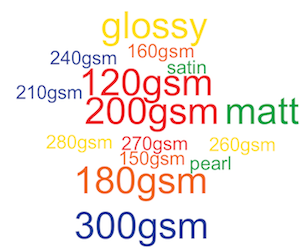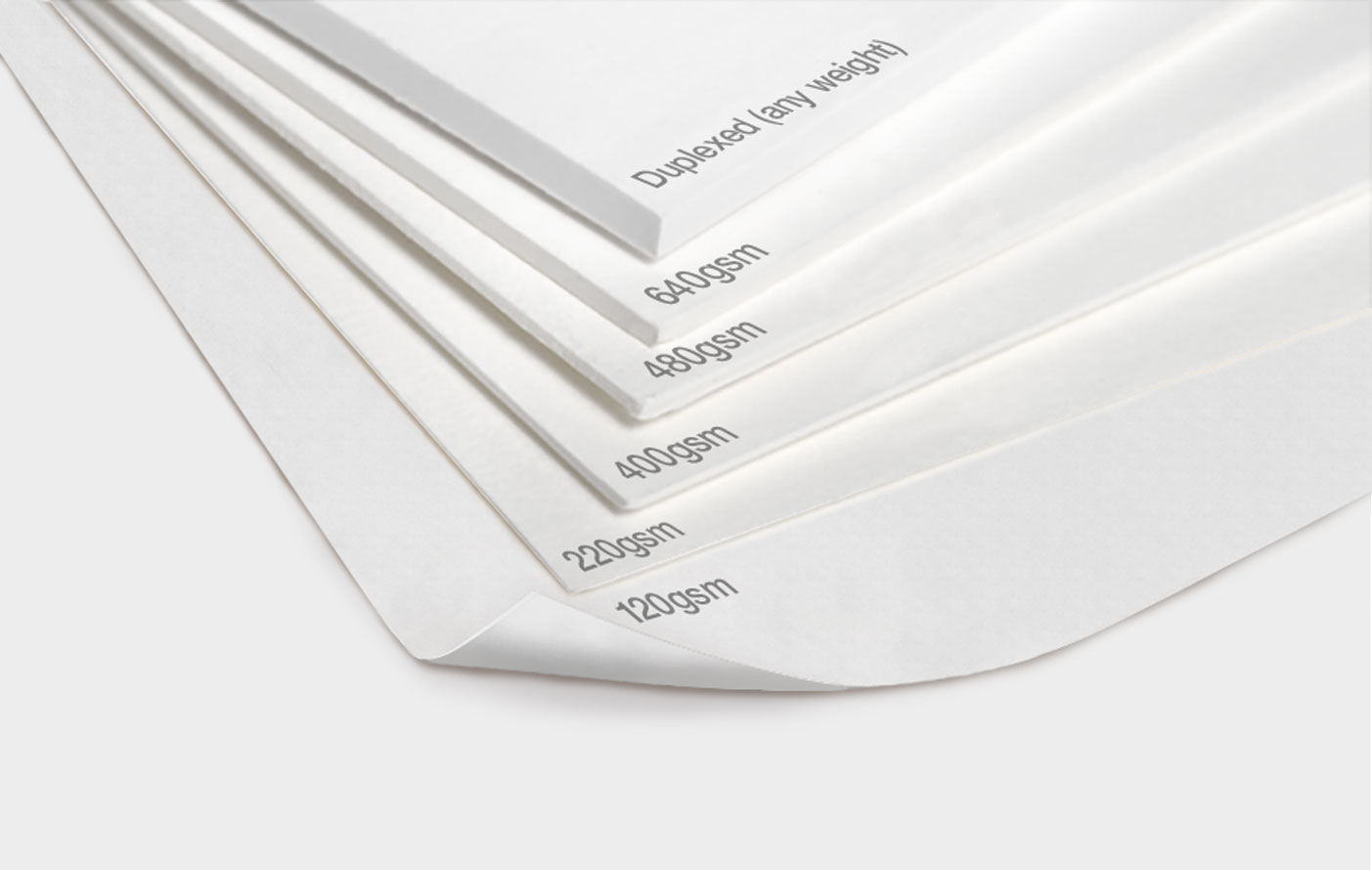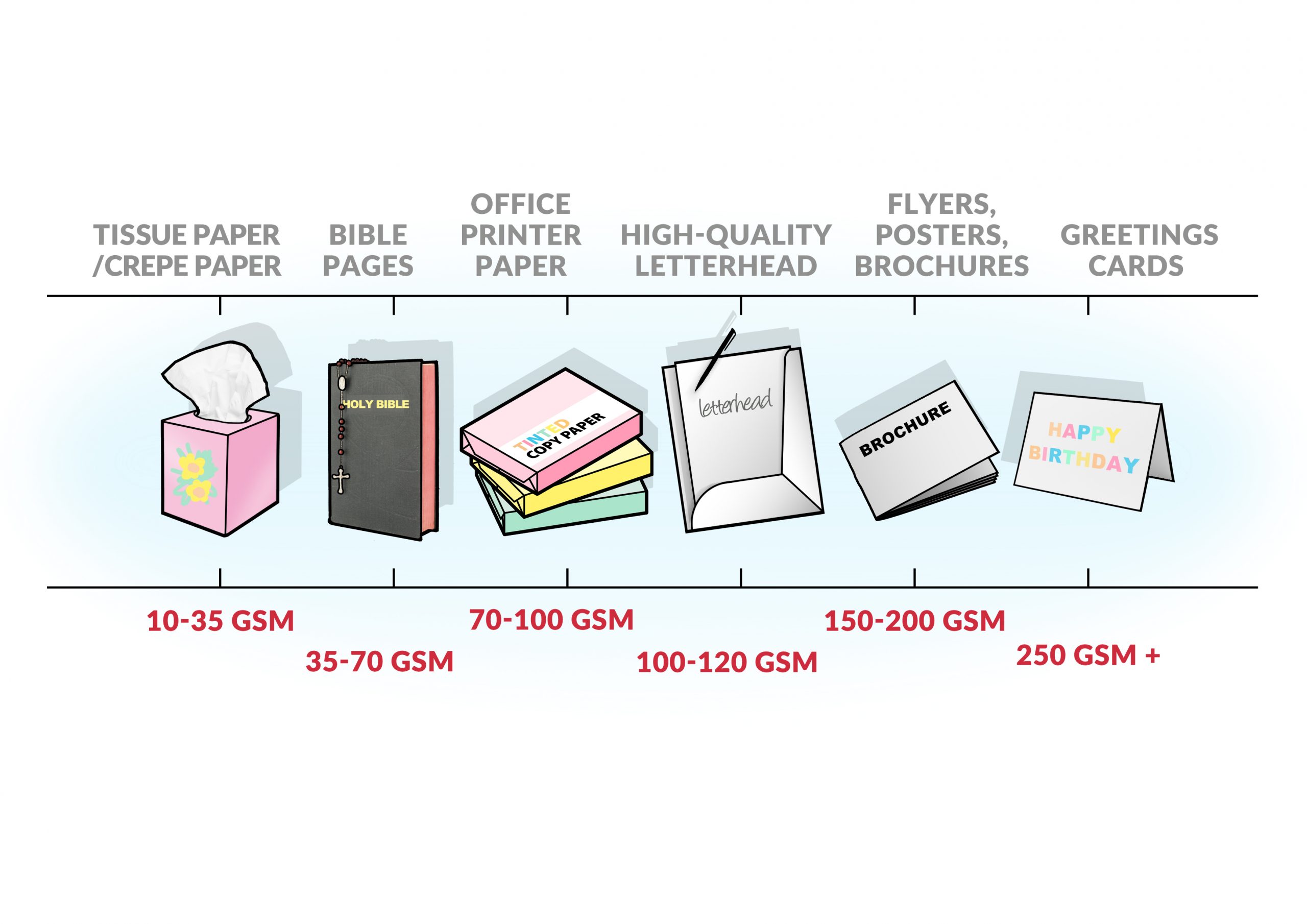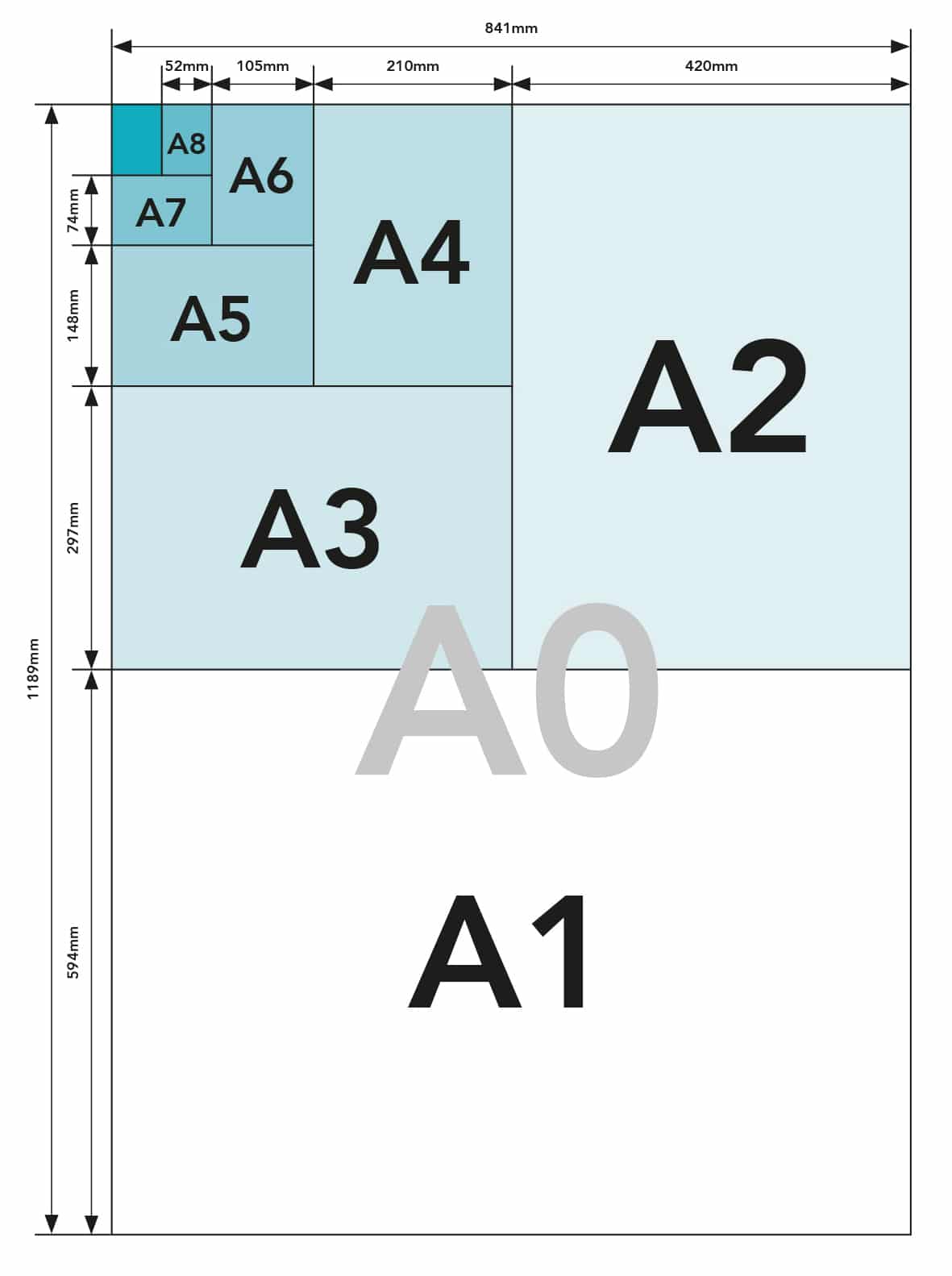Right Paper gsm or thickness for right product.
When we discuss paper grammage, we are alluding to the paper thickness, i.e. the thickness of the sheets. To verify you pick the right sort of paper for your printed item, I thought I’d provide for you a rundown of the different sorts of paper: covered/craftsmanship paper, postcard board, counterbalance paper (copier/printer paper), and publication paper. We’ll be investigating every kind and the contrasts between them, and also at our printed items and the papers on offer for them.
What does GSM mean?
GSM remains for ‘Grams every Square Meter’, It’s an estimation of paper quality which takes into account printers to be much more exact than they could be with wooly terms like ‘thick’, “thin” and ‘kinda in the center’. As the name recommends, it lets you know the amount of a square meter of the paper or card you’re utilizing would weigh (as a part of grams, trust it or not). Despite the fact that everybody has a tendency to think regarding thickness, with premium print being on thicker paper, its a great method for institutionalizing the business and verifying that clients realize what they’re getting.
Diverse paper grammages
In discussing various types of paper, its most likely best to say the “surface feel”, which is the way paper experts depict the composition of the paper to the touch; the surface feel can let you know a ton about the paper, e.g. size, forms, surface composition, weight, and solidness.
Offset(uncoated) paper
Otherwise called copier or printer paper, balance paper is often utilized for letters and note pads in light of the fact that it can be composed and printed on again and again; this makes it suitable for copiers, ink-plane, and laser printers.
Balanced has high shine and an “unpleasant” surface, which permits it tackle color better. It can be composed or printed on without restraint in light of the fact that no water-based covering is connected.
Art (coated) paper
Covered or craftsmanship paper is made of concoction mash which regularly has a high non-wood rate. The matt or reflexive completion connected and the water-based covering (scattering covering) connected gives a smooth, shut surface which makes this paper harder to compose, print, or stamp onto. The scattering covering seals the color and gives the paper expanded steadiness, which prompts brilliant printed pictures with sharp complexities. Covered paper is the ideal outline printing sheet, simply a good fit for flyers, leaflets, and comparable visual items.
Poster paper
With a grammage of 115gsm, notice paper is hard-wearing and climate confirmation, woodfree white with a matt covering on one side. The blue back side keeps whatever is behind the paper from demonstrating through the notice once it has been stuck up; the paper’s translucent premise and its UV safety make it especially suitable for open air utilization.
Postcardboard/ chromo board
Cardboard utilized for post cards is regularly called chromo board, and is slightly mixture in the middle of workmanship and counterbalance paper as one side is varnished and given a water-based covering, making it unsatisfactory for composing on, while the back side is left matt. Because of the high steadiness of chromo board, it is especially valuable for postcards or presentational materials which need to be writable on one side.
You might find this overview useful when choosing the right paper for your product:
- Which paper thickness is weight (gsm) is suitable for printing Business cards (one and two sided)
-> Business cards tend to be in heavy use, so the paper should be stable.
250 gsm art paper (silk finish)
250 gsm art paper (gloss finish)
280 gsm postcardboard
300 gsm art paper (silk finish)
300 gsm art paper (gloss finish)
350 gsm postcardboard
400 gsm thick art paper (silk finish)
400 gsm thick art paper (gloss finish)
Business cards (four sided)
-> The paper should also be stable, but with folds not too thick.
-> If you are setting a fold in colour, we recommend creasing from a grammage of 250gsm onwards so that the colour does not split at the fold.
170 gsm art paper (silk finish)
170 gsm art paper (gloss finish)
250 gsm art paper (silk finish)
250 gsm art paper (gloss finish)
300 gsm art paper (silk finish)
300 gsm art paper (gloss finish) - Which paper thickness is weight (gsm) is suitable for printing Letterheads (one sided)
-> In view of postage costs, lighter paper can bring real savings.
80 gsm copy/printing paper
90 gsm copy/printing paper
100 gsm copy/printing paper
Letterheads (two sided)
-> If you’re printing a letter on both sides, you’ll need slightly thicker paper so that nothing shows through.
80 gsm copy/printing paper
90 gsm copy/printing paper
100 gsm copy/printing paper - Which paper thickness is weight (gsm) is suitable for printing Brochures with/without cover
with Staple binding, Perfect binding, Loop binding or Spiral binding
-> The paper can be thicker if you have a low number of pages or if it’s a corporate image brochure.
-> If you have a large number of pages, you should have a maximum grammage of 135 gsm.
-> If you are setting a fold in colour, we recommend scoring from a grammage of 170 gsm onwards so that the colour does not split at the fold.
-> According to the type of brochure and the kind of binding used, you can choose from the paper grammages set out here.
80 gsm copy/printing paper
90 gsm art paper (silk finish)
90 gsm copy/printing paper
100 gsm copy/printing paper
115 gsm art paper (silk finish)
115 gsm art paper (gloss finish)
135 gsm art paper (silk finish)
135 gsm art paper (gloss finish)
170 gsm art paper (silk finish)
170 gsm art paper (gloss finish)
250 gsm art paper (silk finish)
250 gsm art paper (gloss finish) - Which paper thickness is weight (gsm) is suitable for printing Poster (one sided)
-> A0 to A3 posters with small print runs are generally best printed on photo papers like these.
130 gsm outdoor paper
190g/m² photo paper (gloss finish)
240 g/m² photo paper (gloss finish) - Which paper thickness is weight (gsm) is suitable for printing Ad Posters (one and two sided)
-> To be hung on glass surfaces which can be viewed from both sides: shop windows, etc.
-> Given the colour intensity of neon paper (dayglow paper) this is best used for monotone/black printing.
-> Due to its consistency, poster paper is well suited to outdoor use; its blue background stops coloured backgrounds from showing through.
90 gsm art paper (silk finish)
115 gsm affiche paper
115 gsm art paper (silk finish)
115 gsm art paper (gloss finish)
135 gsm art paper (silk finish)
135 gsm art paper (gloss finish)
170 gsm art paper (silk finish)
170 gsm art paper (gloss finish)
250 gsm art paper (silk finish)
250 gsm art paper (gloss finish)
300 gsm art paper (silk finish)
300 gsm art paper (gloss finish) - Which paper thickness is weight (gsm) is suitable for printing Flyers (one and two sided)
-> 90–135 gsm is good for flyers in brochures, etc.
-> 135–170 gsm is best for classic flyers.
-> 250–300 gsm is almost like cardboard.
90 gsm art paper (silk finish)
90 gsm copy/printing paper
100 gsm copy/printing paper
135 gsm art paper (silk finish)
135 gsm art paper (gloss finish)
170 gsm art paper (silk finish)
170 gsm art paper (gloss finish)
250 gsm art paper (silk finish)
250 gsm art paper (gloss finish)
300 gsm art paper (silk finish)
300 gsm art paper (gloss finish)
400 gsm art paper (silk finish)
400 gsm art paper (gloss finish) - Which paper thickness is weight (gsm) is suitable for printing Folded leaflets (4, 6, 8 and 10-sided)
-> If you are setting a fold in colour, we recommend scoring from a grammage of 170 gsm onwards so that the colour does not split at the fold.
-> 250 gsm is an unusual grammage for folded leaflets, but is popular for large-sized prints due to its stability.
80 gsm copy/printing paper
90 gsm art paper (silk finish)
90 gsm copy/printing paper
100 gsm copy/printing paper
135 gsm art paper (silk finish)
135 gsm art paper (gloss finish)
170 gsm art paper (silk finish)
170 gsm art paper (gloss finish)
250 gsm art paper (silk finish)
250 gsm art paper (gloss finish) - Which paper thickness is weight (gsm) is suitable for printing Calendar (wall/desk/pocket)
-> Thanks to spiral binding, creasing is only needed on higher grammages if they are used for four-sided pocket calendars.
-> The paper grammages shown can be selected according to the type of calendar.
170 gsm art paper (silk finish)
170 gsm art paper (gloss finish)
250 gsm art paper (silk finish)
250 gsm art paper (gloss finish)
300 gsm art paper (silk finish)
300 gsm art paper (gloss finish)
400 gsm art paper (silk finish)
400 gsm art paper (gloss finish) - Which paper thickness is weight (gsm) is suitable for printing DVD/CD covers
-> 80–135 gsm is suitable for greater numbers of page given the limited space available in a CD case.
-> Highly stable 170–250 gsm is good for covers with lower numbers of pages.
80 gsm copy/printing paper
90 gsm copy/printing paper
90 gsm art paper (silk finish)
100 gsm copy/printing paper
135 gsm art paper (silk finish)
135 gsm art paper (gloss finish)
170 gsm art paper (silk finish)
170 gsm art paper (gloss finish)
250 gsm art paper (silk finish)
250 gsm art paper (gloss finish)
300 gsm art paper (silk finish)
300 gsm art paper (gloss finish)
400 gsm art paper (silk finish)
400 gsm art paper (gloss finish) - Which paper thickness is weight (gsm) is suitable for printing CD Booklets
-> 80–135 gsm is suitable for greater numbers of page given the limited space available in a CD case.
-> Highly stable 170–250 gsm is good for covers with lower numbers of pages.
80 gsm copy/printing paper
90 gsm copy/printing paper
90 gsm art paper (silk finish)
100 gsm copy/printing paper
135 gsm art paper (silk finish)
135 gsm art paper (gloss finish)
170 gsm art paper (silk finish)
170 gsm art paper (gloss finish) - Which paper thickness is weight (gsm) is suitable for printing Postcards
-> Postcardboard is the classic choice for tourist postcards.
250 gsm art paper (silk finish)
250 gsm art paper (gloss finish)
280 g/m² postcardboard
350 g/m² postcardboard
300 gsm art paper (silk finish)
300 gsm art paper (gloss finish)
400 gsm art paper (silk finish)
400 gsm art paper (gloss finish) - Which paper thickness is weight (gsm) is suitable for printing Notepads
-> Notepads are printed on one side with a grey cardboard back and available optionally with 2 punches or 4.
80 gsm copy/printing paper
90 gsm copy/printing paper
After all the portrayals and clarifications here, you may need to get a vibe for the scope of papers accessible yourself, in which case you are welcome to request print paper sample. On the off chance that you have some other inquiries, I’ll be content to answer them on the off chance that you post them in the remarks box.
Paper Type
| Paper Finishing | Description |
| Matt Paper | Matt coated finish not shiny or Glossy. |
| Silk / Satin Paper | In between Matt and Gloss Finish.Perfect for all kind of use. |
| Gloss or Glossy Paper | Glossy finish & ultra-smooth to shiny appearance |
| Uncoated / Offset / Bond Paper | Not a smooth coated paper & rough surface very close to textured |
Paper Thickness
| Paper Weight or GSM | Common Used Products |
| 75gsm / 80gsm Uncoated paper | Thin uncoated paper mainly use for Copy,Letters or daily printing |
| 100gsm Uncoated paper | Thicker then normal copy paper good for Receipts. |
| 120gsm Uncoated paper | Good thickness uncoated paper great for quality Letterheads and Complement slips. |
| 130gsm Matt/Silk/Satin/Gloss | Flyers & leaflets printing paper good example will be Takeaway menu paper or Poster |
| 170gsm Matt/Silk/Satin/Gloss | Thick flyer paper great for quality leaflets,Booklets,Brochures etc. |
| 250gsm Matt/Silk/Satin/Gloss | Entry level card stock not too thick but not too paper thickness. Good for Post cards |
| 300gsm Matt/Silk/Satin/Gloss | Standards card stock good for greeting cards,table menu, invitations ,Taxi cards. |
| 350gsm Matt/Silk/Satin/Gloss | Thick card stock good for quick Name cards , Business cards, appointment cards etc. |
| 400gsm Matt/Silk/Satin/Gloss | Extra thick card stock perfect for High quality professional looking Business cards. |
Paper Sizes
| Standard Paper Sizes In UK | Without Bleed or Finish Size | With Bleed (Before Cutting the sides) | Common Used Products |
| A0 | 1189x841mm | Big Poster good for Academic presentation poster & others | |
| A1 | 841x594mm | Half of A0 Size good for event, wall posters & others. | |
| A2 | 594x420mm | Half of A1 good for portfolio ,Architectural drowning & others | |
| A3 | 420x297mm | Standard Poster size not too big not too small good for bulk Order | |
| A4 | 297x210mm | Standard Copy paper size good for letter, news letter etc. | |
| A5 | 210x148mm | Half of A4 ( Copy paper size) great for flyers, Leaflets etc | |
| A6 | 148x105mm | 1/4 of ( Copy paper size) great for flyers, postcards, invites etc | |
| A7 | 105x74mm | Slightly Bigger then standards Business cards size. | |
| A8 | 74x52mm | Smaller then business cards great for small vouchers,Flyers etc | |
| DL ( Also Known As 1/3 A4) | 99x210mm | 1/3 A4 size or finish size of a A4 size letter when we fold the paper twice and good example will be daily letter envelope size |





